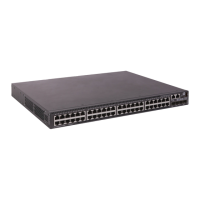85
Managing the file system
This chapter describes how to manage the device's file system, including the storage media, directories,
and files.
IMPORTANT:
• Before managing storage media, files, and directories, make sure you know the possible impacts.
• A file or directory whose name starts with a period (.) is considered a hidden file or directory. Do not
give a common file or directory a name that starts with a period.
• Some system files and directories are hidden.
FIPS compliance
The device supports the FIPS mode that complies with NIST FIPS 140-2 requirements. Support for features,
commands, and parameters might differ in FIPS mode and non-FIPS mode. For more information about
FIPS mode, see Security Configuration Guide.
File name formats
IMPORTANT:
Enter a storage medium name in lower case, including the chassis and slot strin
s (if any). Otherwise, the
following error message is displayed: "The file or directory doesn't exist." Folder names and file names
are case insensitive.
When you specify a file, enter the file name in one of the formats shown in Table 11. When you specify
a directory, follow the rules for the drive and path arguments.
Table 11 File name formats
Format Descri
tion
Exam
le
file-name
Specifies a file in the current working
directory.
a.cfg indicates a file named a.cfg in the
current working directory.
[path/]file-name
Specifies a file in a folder in the current
working directory.
The path argument represents the path
to the file. If the file is in a single-level
folder, specify the folder name for the
argument. If the file is in a nested
folder, separate each folder name by a
forward slash (/).
• test/a.cfg indicates a file named a.cfg
in the test folder in the current working
directory.
• test/subtest/a.cfg indicates a file
named a.cfg in the subtest subfolder
of the test folder in the current working
directory.

